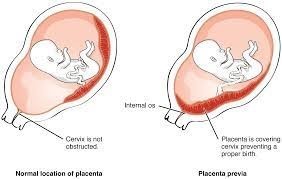A nurse is assisting with the care of a client who is in the latent stage of labor and has pelvic pain with contractions.
Which of the following actions should the nurse take?
Apply fundal pressure during contractions.
Instruct the client to change positions frequently.
Tell the client to push during contractions.
Encourage the client to soak in a hot bath.
The Correct Answer is B
Explanation
B. Instruct the client to change positions frequently
Encouraging the client to move around, walk, change positions during labour can help relieve discomfort, promote optimal fetal positioning positions, or use a birthing ball can help alleviate pelvic pain and potentially facilitate the progress of labour.
Applying fundal pressure during contractions in (option A) is not necessary during the latent stage of labour. Fundal pressure is typically used in the active stage of labour to assist with the descent and positioning of the baby's head.
Telling the client to push during contractions in (option C) is not appropriate during the latent stage of labour. Pushing is typically reserved for the second stage of labour when the cervix is fully dilated.
Encouraging the client to soak in a hot bath in (option D) is not recommended during labour, particularly in the hospital setting. Immersion in hot water (e.g., a hot bath) can increase the risk of infection and is generally not recommended until after the birth of the baby
Nursing Test Bank
Naxlex Comprehensive Predictor Exams
Related Questions
Correct Answer is A
Explanation
Placenta previa is a condition where the placenta partially or completely covers the cervix, leading to vaginal bleeding. The bleeding is typically painless and bright red in color. This is an important finding that should be assessed and monitored closely.

A rigid abdomen is not a characteristic finding of placenta previa. It could be a sign of another condition such as placental abruption or uterine rupture, which are separate complications. Fetal movement is not directly related to placenta previa. It is a normal finding and can vary depending on the gestational age and individual fetal patterns.
Placenta previa is not typically associated with persistent uterine contractions. However, it is important to monitor for any signs of preterm labor or other complications that could cause uterine contractions.
Correct Answer is C
Explanation
Explanation
C. Position the client on their left side
The symptoms of feeling dizzy, racing heart, and becoming pale while lying on their back are consistent with supine hypotensive syndrome or vena cava syndrome. This condition occurs when the pregnant uterus compresses the vena cava, reducing blood flow back to the heart and causing a drop-in blood pressure.
Positioning the client on their left side helps alleviate the pressure on the vena cava, allowing for improved blood flow and preventing further symptoms. This position optimizes blood circulation and reduces the risk of complications. The nurse should assist the client in turning onto their left side and ensure they are comfortable.
Providing the client with a glass of orange juice (option A) is not recommended as it may be helpful in cases of low blood sugar or hypoglycemia, but it is not the most appropriate action in this scenario.
Instructing the client to take a brisk walk (option B) is not recommended since physical exertion can further worsen the symptoms and increase the risk of complications.
Checking the client's temperature (option D) is not necessary as the reported symptoms are not indicative of a fever or infection.
Therefore, the most appropriate action for the nurse to take in this situation is to position the client on their left side (option C).
Whether you are a student looking to ace your exams or a practicing nurse seeking to enhance your expertise , our nursing education contents will empower you with the confidence and competence to make a difference in the lives of patients and become a respected leader in the healthcare field.
Visit Naxlex, invest in your future and unlock endless possibilities with our unparalleled nursing education contents today
Report Wrong Answer on the Current Question
Do you disagree with the answer? If yes, what is your expected answer? Explain.
Kindly be descriptive with the issue you are facing.
